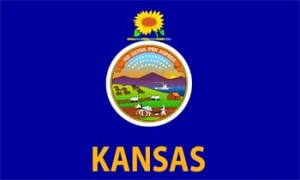Kansas Emergency Vehicle Light State Statutes
 Emergency responding officers are a paramount part of public safety. When an emergency occurs, there are a number of officials trained to respond. The main method of transportation is an authorized emergency vehicle. Different vehicles are optimized to respond to different types of emergencies. The different emergencies also require different warnings. In Kansas, state statutes outline the warning lights and sounds that must be used by different emergency vehicles.
Emergency responding officers are a paramount part of public safety. When an emergency occurs, there are a number of officials trained to respond. The main method of transportation is an authorized emergency vehicle. Different vehicles are optimized to respond to different types of emergencies. The different emergencies also require different warnings. In Kansas, state statutes outline the warning lights and sounds that must be used by different emergency vehicles.
Police Lights
The codes for police vehicles are outlined in Kansas state statute 8-1720(a) and 8-172-(b). Police vehicles can be used as an authorized emergency response vehicle, but this isn't always the case. When responding to an emergency, police vehicles are required to use the following emergency vehicle lighting:
- Headlights that flash from low to high beam, or from high to low beam, in order to get the attention of other motorists
- Signal lamps that flash red, each mounted on the roof or highest possible point of the vehicle, spaced far enough to provide 360 degree visibility
- Alternatively, signal lamps that flash red and white or red and blue
If flashing police lights aren't available, a police car might also display oscillating lights that either display red flashes or alternate blue and red flashes. Regardless of the light's color, the signal must be visible from at least 500 feet in all directions.
Firetruck Lights
Fire trucks qualify as an authorized emergency vehicle. When a fire truck is en route to or stationed at an emergency scene, the vehicle must display flashing red lights. The lamps are required to be mounted at the highest possible point. One should be placed at either side of the vehicle to ensure 360 degree visibility.
The lights must be mounted at the same height. If flashing lights aren't available, a firetruck must have at least one rotating light mounted on its roof or highest possible point. This light must flash red at both the front and back of the vehicle; if the light is obscured by one side of the vehicle, multiple lights must be used.
Every light displayed by a fire truck must be visible within 500 feet in normally sunlit conditions. The red warning fire truck lights are required by law. It's optional for a firetruck to have headlights that can flash between high and low beam, according to state statute 8-1720(a).
Volunteer Firefighter Lights
According to state statute 8-2010a(4), a privately-owned vehicle belonging to a volunteer firefighter can be designated as an authorized emergency vehicle. However, to do so, the vehicle's owner must file an application with the county commissioner.
After the application has been filed, this vehicle can respond to relevant emergencies, according to state statute 8-2010.
To be used as an emergency vehicle, a volunteer firefighter's vehicle must be registered, and the county clerk's office must determine that the vehicle's use is necessary to preserve property or life. Designations are made in writing. After the firefighter obtains this designation, it should be kept in the vehicle with the registration papers.
While a privately owned vehicle is being used as an emergency response vehicle, it's subject to the same light laws as other emergency vehicles. This means that the driver must mount a flashing or rotating red light on their roof. It must be visible in 360 degrees from a minimum of 500 feet.
Ambulance Lights
Ambulances are subject to the same light laws outlined in state statute 8-1720. All requirements are exactly the same as those governing firetrucks.
Tow Truck Lights
According to Kansas state statute HB 378, tow trucks are covered under the state's "move over" law. This law requires passing motorists to move over one lane for the safety of public service workers.
Statute 547.305> describes the requirement for a vehicle to have flashing lights equipped. Section (d)(4) refers to tow trucks that are currently being directed by law enforcement officials, either while hooking into a disabled vehicle or clearing an accident.
Also included are tow trucks that have mounted light bars with both turn signals and stop lamps. The driver must equip flashing lights, although they should not use these lights unless they are responding to a potential emergency.
Construction Vehicle Lights
 Vehicles at construction sites are not considered emergency vehicles. Construction sites are, however, subject to the state "move over" law. According to state statute 378, the "move over" law requires passing vehicles to vacate a lane directly beside a construction site.
Vehicles at construction sites are not considered emergency vehicles. Construction sites are, however, subject to the state "move over" law. According to state statute 378, the "move over" law requires passing vehicles to vacate a lane directly beside a construction site.
Construction vehicles must use standard yellow and white headlights. They must also adhere to all headlight requirements, including the stipulation that lights mounted above 42 inches cannot be pointed at a highway. If a construction vehicle needs to move along an in-use roadway, it should either display flashing headlights or have an escort vehicle with appropriate warnings.
Utility Vehicle Lights
State statute 8-2010a(b)(3) explains that utility vehicles can be designated as an authorized emergency vehicle. For this designation to be granted, the utility company must file an application with their county commissioner's office. It's the same procedure required for volunteer firefighters.
Upon the approval of the application, the designation paperwork must be kept in the vehicle at all times. Utility vehicles can only utilize their emergency vehicle status when responding to an emergency. At this point, they must adhere to emergency vehicle protocol by displaying flashing or rotating red strobe lights. This is particularly important when the vehicle is working with power lines in or very near the road.
Pilot Vehicle Lights
Pilot vehicles, also known as escort vehicles, are used to warn motorists about oversized loads. If an oversized load is piloted, the state of Kansas requires two escort vehicles for any width greater than 14 feet traveling on roads with fewer than 4 lanes. For oversized loads exceeding 14 feet and traveling on roads with 4 or more lanes, only one frontal escort vehicle is required. The exception would be if a superload was being transported, in which case a rear escort is also necessary.
All escorts are required to have an "Oversize Load" sign. The widest area of the load must have fluorescent flags in either red or orange, with a fabric quantity of at least 18 square inches. According to the Kansas Highway Patrol, no specific lights are required provided the flags are properly displayed.
Security Vehicle Lights
The state of Kansas does not have any statutes which authorize mall security as an emergency vehicle. Legally, non-emergency security vehicles must abide by the same rules that an average motorist uses. The drivers must comply with all rules of the road, including headlight regulations and "move over" laws. Headlights should only be used with their high beams when the vehicle is not within sight of any other vehicles. Because these vehicles aren't designated as emergency vehicles, they aren't permitted to use emergency warning colors. Instead, they'll have standard yellow or white headlight beams.
For more information about what lights may be available to you, we suggest calling your State Highway Patrol office at: 785-296-3102
*Please note that these numbers are what we are currently able to find and the numbers may have changed since this listing.
Disclaimer: The emergency vehicle light state statute guide was created by Extreme Tactical Dynamics as a guide and reference. We make no claim to the accuracy or validity of this guide. This guide was written to the best of our knowledge and has been provided to our customers as a courtesy ONLY! The information in this guide is our interpretation of the law as we have read it. We cannot be held responsible for any errors as this is only our interpretation of the law and the laws are constantly changing. We cannot be held liable or responsible for any errors and recommend that our customers refer to their local authorities to confirm the particular statue that governs their use of emergency vehicle lights.
 Facebook
Twitter
Google+
Instagram
YouTube
Facebook
Twitter
Google+
Instagram
YouTube


